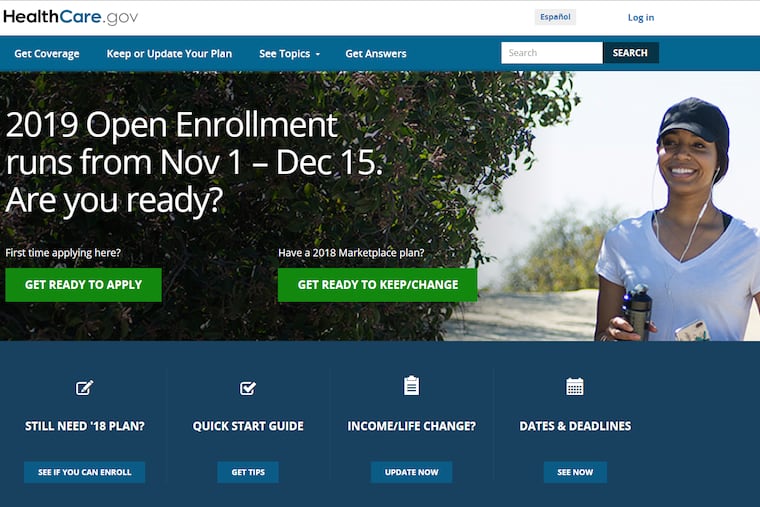Premiums for ACA health plans to decline 16 percent in Pa.
Individual rates for the second-lowest cost silver plan in 2019 will decline an average of 16 percent in Pennsylvania and an average of 15 percent in New Jersey.

After years of double-digit premium rate increases, people who buy health plans through the Affordable Care Act marketplaces in Pennsylvania and New Jersey for 2019 will see some of the largest rate decreases in the country among states that use the federally run healthcare.gov marketplace.
Individual rates for the benchmark second-lowest cost silver plan in 2019 will decline an average of 16 percent in Pennsylvania and an average of 15 percent in New Jersey, according to data released Thursday by the U.S. Centers for Medicare & Medicaid Services.
The open enrollment period for plans that take effect at the beginning of the year is Nov. 1 through Dec. 15.
Pennsylvania and New Jersey are among the 39 states that use the federally run insurance marketplace, rather than setting up their own. Among those 39 states, premiums will decline an average of 1.5 percent for 2019.
The Trump administration long has advocated for eliminating the Affordable Care Act, insisting that premiums are too high. President Trump has frequently described the program as "failing," and stopped paying subsidies to insurers that cover many low-income Americans, a move observers thought might sink the ACA. Yet in a call with reporters Thursday morning, CMS Administrator Seema Verma said Trump administration policies are the reason for the rate decreases.
"While we are encouraged by this progress, we aren't satisfied. Even with this reduction, average rates are still too high. If we are going to truly offer affordable, high quality healthcare, ultimately the law needs to change," Verma said in a statement.
She spoke about eliminating the penalty for people who don't buy insurance and expanding access to short-term health plans, which are less expensive because they often do not cover certain benefits, such as maternity and mental-health care. Both measures were expected to reduce the number of people buying insurance through the exchanges, which analysts predicted could actually drive up prices.
Analysts have said the skimpier plans and penalty elimination could also lead to more people purchasing coverage that doesn't meet all their needs or skipping insurance entirely.
"Arguably, rates would be going down much more dramatically in 2019 if the Trump administration had not made the policy decisions it had made," said Sabrina Corlette, a research professor at the Center on Health Insurance Reforms at Georgetown University's Health Policy Institute.
Rather, the rate decrease for 2019 reflects a "recalibration" from the sharp increases of 2018. In anticipation of eliminating the individual mandate and expanding access to skimpier health plans, insurers secured a 37 percent increase nationally.
In New Jersey, rates for the 2018 benchmark silver plan went up 19 percent and in Pennsylvania, rates shot up 46 percent from the year before.
"A lot of insurers are saying, 'OK, they've thrown the worst they can at us and we've weathered the storm," Corlette said.
Income-based tax credits that help offset the cost of premiums have also helped stabilize the marketplace, she said.
New Jersey, which released its rates in September, attributed the decrease to the fact that it is requiring most people to buy insurance or pay a penalty. A new reinsurance fund to help insurers cover the cost of their most expensive members also has helped push rates down, officials said. Short-term plans are banned in New Jersey.
Insurance carriers told New Jersey regulators that without those efforts, individual rates would have gone up, said Marlene Caride, commissioner of New Jersey's Department of Banking and Insurance.
"Despite the federal government's intentional sabotage of the Affordable Care Act, the Murphy administration is doing everything possible in New Jersey to stabilize the market and is demonstrating success," Caride said in a statement.
Health plans sold through the online marketplace are labeled bronze, silver, gold or platinum. Bronze plans offer the lowest premiums with higher deductibles and cost-sharing, and platinum plans offer higher premiums and greater coverage.
The second-lowest silver plan — a benchmark that regulators have used to compare marketplace plans — will cost an average of $289 a month for an individual in New Jersey, according to estimates released Thursday by CMS.
In Pennsylvania, the second-lowest silver plan for an individual will cost $397 a month. The state's insurance department plans to release rates for individual insurers next week.
The estimates are for a 27-year-old nonsmoker. Rates are higher for older people and smokers because of their greater care needs.
Philadelphia-area residents who turn to the health exchange for insurance this fall will also find more options than last year, when Independence Health Group was the only insurer to offer plans through the exchange in the five-county area.
Pennsylvania Health & Wellness Inc., operated by Centene Corp. in St. Louis, will offer plans in Bucks, Montgomery and Philadelphia Counties. Geisinger Health Plan, which is owned by Geisinger Health System of Danville, Pa., submitted rate proposals for those counties as well as Chester and Delaware Counties, but a spokesman said the group ultimately decided against offering plans in the Philadelphia area.
"When we see increased competition, that's great. When we see decreases in rates, that's great, too. But folks need to look at the full picture of what goes into health insurance coverage," said Antoinette Kraus, director of Pennsylvania Health Access Network, which helps people sign up for health insurance.
People shopping for insurance need to also consider the plan's deductible, co-insurance and co-payments, whether their doctors are in the plan's network, and how their medications are covered before concluding that the lowest-premium plan is really a bargain.
Editor's note: An earlier version of this story said that Geisinger Health Plan would introduce its health plans to the Philadelphia market for 2019. The group filed rate proposals with the state, but decided against expanding to the five-county area.